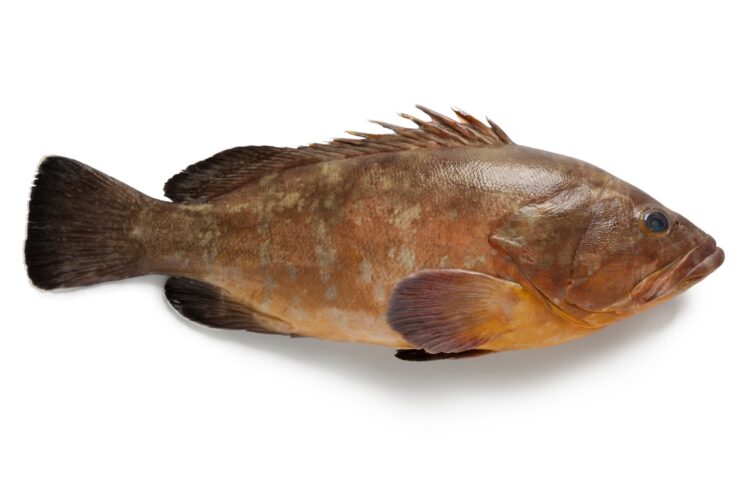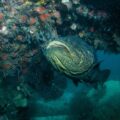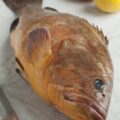Epinephelus marginatus, also known as the dusky grouper, yellowbelly rock cod, or yellowbelly grouper, is a ray-finned fish in the sea. It is in the family Serranidae, which also includes anthias and sea bass. Several grouper species live along the Mediterranean and North African coasts, but this one is the most well-known.
The stony reefs of the Mediterranean Sea, eastern and southern Atlantic Oceans, and western Indian Ocean are home to the dusky grouper. Occasionally weighing in at over 50 kilos, this fish can grow to be 1.5 meters in length.
Every member of this and other grouper species begins life as a female but at a specific age and size does it transition into a male. It is estimated that the median age for this gender switch is 12 years old.
Description of Dusky Grouper
The dusky grouper is a huge, oval-shaped fish with a wide mouth and a lower jaw that sticks out. This grouper is dark reddish brown or grayish on the head and upper body, with yellowish gold countershading on the ventral surfaces. The base color is marked by a vertical series of irregular pale greenish-yellow, silvery grey, or white spots, which is usually easy to see on the body and head. The black maxillary streak, which varies in how noticeable it is. The dark brown median fins and the tips of the anal, caudal, and sometimes pectoral fins, and the black maxillary stripe, which varies in how noticeable it is. Thirteen to sixteen soft rays and eleven sharp spines make up the back fin. This species could grow to be 150 cm long at most (often 90 cm).

Facts on the Dusky Grouper
- A dusky grouper’s diet consists primarily of crabs, octopuses, and reef fish.
- The foggy origin of its scientific name is a nod to the faint spots on its skin.
- Dusky grouper juveniles inhabit rocky tidal pools along the coast.
- It is not recommended to keep this species in an aquarium.
Distribution of Dusky Grouper
The dusky grouper lives mostly in the eastern Atlantic, from the western coast of Iberia south along the western coast of Africa to the Cape of Good Hope. It then goes east into the southwestern Indian Ocean, as far as southern Mozambique, and there may be records of it in Madagascar and even Oman. It is also found in the Mediterranean area. The second group lives in southwest South America in the Atlantic Ocean.
They live in the waters off the coasts of southern Brazil, Uruguay, and northern Argentina. Rare sightings have been reported from the Bay of Biscay and the English Channel all the way to northern France, Great Britain, and Ireland, but it usually doesn’t go that far north in the eastern Atlantic.
Habitat
The demersal dusky Grouper lives on and around rocky reefs up to 300 meters deep. Most of the time, this happens in seagrass beds. Even you can find young fish in rock pools since they tend to stay closer to the shore than older fish. Both adults and juveniles can be found in shallow waters in protected areas like marine nature reserves and no-take zones. However, juveniles are always found at shallower depths than adults.
Even though adults are solitary and territorial and prefer places with a stony bottom, adults and young dusky groupers will enter brackish environments like estuaries. Most of what they eat are mollusks, crabs, and octopuses. As they get bigger, though, other fish, especially reef fish, make up a bigger part of their diet.
Sexual Traits and Reproduction
The Dusky Grouper is a protogynous hermaphrodite, which means that it starts out as a female but turns into a male as it grows up. They don’t become sexually active until they’re in their late teens, and females don’t start having babies until they’re in their early fifties, if they were aged the same as humans. The fish start to change from females to males when they are 65 cm long, but most don’t finish the process until they are 80–90 cm long. Some fish populations have huge females, which could mean that not all females undergo sexual maturation.
Dusky grouper have their young in the early summer, between November and December, off the coast of Brazil. During spawning, dominant males set up their territories and protected them from other males and smaller females. Some reports say that it could be as long as 50 years.
During the breeding season, they gather in small groups of ten or so at places where they are allowed to spawn. E. marginatus usually spawns in the Mediterranean, in places like the Medes Islands Marine Reserve in Spain, the waters off Lampedusa in Italy, and the waters off Port-Cros National Park in France. Brazilian fishermen are pretty sure there are aggregations off the coast of Santa Catarina, but no proof has been found as of yet. In the Mediterranean, polygynous mating happens from June to September, and there are usually seven females for every male in the spawning clusters.
Fishing
Commercial fishermen catch dusky grouper all over its range because its meat is good to eat. On the other hand, spear fishermen often catch big adult fish, which anglers consider trophies. Because this species grows slowly and has an unusual way of reproducing, overfishing could hurt its ability to have children. The aquaculture industry in Italy has tried to raise this species. The dusky grouper is considered a gourmet dish in many parts of the world.
Conservation Around the World
The International Union for the Conservation of Nature has put the dusky grouper in the vulnerable category because it is thought that the population has dropped by more than 50% in the last three generations and that the things that caused this decline are still happening. Spearfishing has been illegal in France for ten years, and both South Africa and Australia have put limits on the number of fish you can catch.
Between 1990 and 2001, the number of dusky groupers caught dropped by 88% in seven countries that together make up a large part of the species’ global range. There isn’t enough information about the status of this fish in places like West Africa, where it is often caught.
Many MPAs have also been set up to protect the dusky grouper’s (Epinephelus marginatus) environment. People have suggested that Turkey set up no-take zones along the coasts of the Aegean and Mediterranean and ban fishing for at least three to five years.
Conclusion
The dusky grouper is a fish species found in the tropical waters of the Atlantic and western coasts of Africa. Its large size makes it an attractive food source for humans and other predators, but its rarity means that overfishing could lead to its extinction.
But if the right steps are taken to protect this species, it could stay abundant throughout its natural range for generations to come. When we know more about the dusky grouper’s life cycle, we can protect it better in the future.











